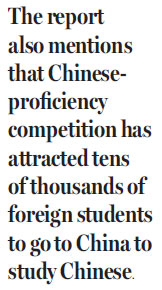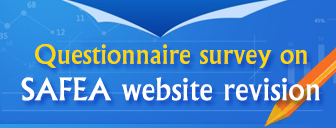Book: Language study key in cultural exchange
By Hong Xiao in New York (China Daily USA)
Updated: 2016-01-04
Chinese-language education has become an important platform for US-China cultural exchange, according to a new report.
The Blue Book of Overseas Chinese 2015 was released jointly by the Overseas Chinese Affairs Office of The State Council, Huaqiao University (equal to Overseas Chinese University) and China's Social Science Academic Press, in Beijing on Dec 23.
The book points out that cultural exchange provides much better support for building a new model of the China-US relationship, and that Chinese-language education is an effective way to promote cultural exchange between the two countries.
In its culture and education chapter, the book noted that "the trips in search of roots in China" and many other Chinese-language education programs overseas have increased American-born Chinese teenagers' and Chinese-language teachers' knowledge of contemporary China, which makes a unique contribution to promote cultural exchange between China and the US.
Statistics show that among all the countries organizing "trips in search of roots in China", the US ranks the most active country, by activity and participant numbers.
From 2014, American-born Chinese youths have participated in 21 trips in searches for roots in China, covering almost 20 cities in 15 provinces in China.
The report also mentions "Chinese Bridge" (the Chinese-proficiency competition for foreign college students) has attracted tens of thousands of foreign students to go to China to study Chinese; and the "100,000 Strong" Initiative that was announced by President Barack Obama in November 2009 has encouraged many students of diverse backgrounds across the US to learn Mandarin and study in China.
According to the report, in the next five years, China will invite 100 US youth leaders to visit and study in China; 1,000 students from each country will enroll as exchange students in top universities in one another's countries.
Still, the book indicates that Chinese-language education faces challenges, for example, the gap between it and mainstream education in the US.
The book suggests that to promote future cultural exchange, the Chinese-language-learning summer camps or winter camps could be extended moderately to non-Chinese student groups in the US, and localized Chinese cultural activities should also extend to non-Chinese communities; Chinese-language teacher-training could open to Chinese-language teachers who are in the American mainstream education system.
To further enter the mainstream, Chinese communities should strive for Chinese-education rights, for example, finding free or low fee-based schoolhouses for Chinese-language schools; promoting teachers at Chinese-language schools to acquire American teaching certificates to fill the Chinese-language teacher gap in American education; and Chinese-language school education should absorb the ideas and methods of American mainstream education.

Jia Yimin, principal of Huaqiao University and chief editor of the blue book, said in the press conference that for writing the book, a great number of in-depth studies on Chinese in the United States, Japan, Malaysia, Thailand, Singapore, Philippines, Indonesia and others had been done by 85 experts across the world.
The studies covered Chinese's role in relations with neighboring countries, the overseas Chinese's fertility rate, Chinese-language education, Chinese charitable contributions, Chinese family business management model, Chinese's cultural identity and public diplomacy.
The objective was to reveal overseas Chinese behavioral patterns from multiple dimensions and scales.
The book is divided into a general report, a neighboring countries relations' chapter, a society chapter, an economy chapter, and a culture and education chapter.
Jia said in an interview that this book has three new features: It pays more attention to overseas Chinese's current living conditions and production modes, which have never been mentioned before;
Secondly, the study theme closely integrates China's current international strategies, especially the "One Belt and One Road" strategy, discussing overseas Chinese's role in those strategies;
Thirdly, it features Chinese society 's cultural well being, cultural communication and cultural development modes under a new world economy and social situation.
The 1.4 million-word book is the fifth in a series, which started publishing in 2011.
xiaohong@chinadailyusa.com
(China Daily USA 01/04/2016 page2)
What we do
SAFEA is responsible for certifying foreign experts to work in the Chinese mainland and organizing overseas training for Chinese technical and managerial professionals.







